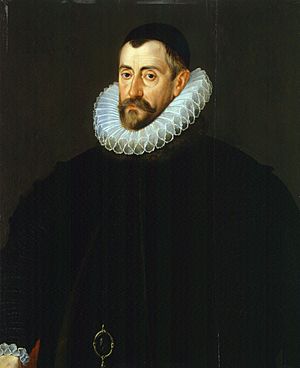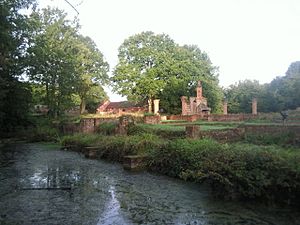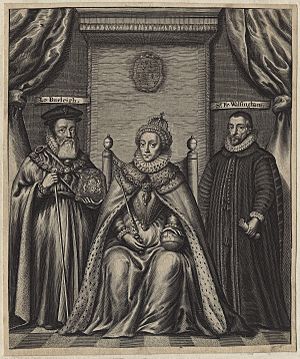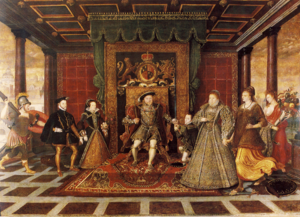Francis Walsingham facts for kids
Quick facts for kids
Sir
Francis Walsingham
|
|
|---|---|

Portrait attributed to John de Critz, c. 1585
|
|
| Secretary of State | |
| In office 1573–1590 |
|
| Monarch | Elizabeth I |
| Personal details | |
| Born | c. 1532 probably Chislehurst, Kent, England |
| Died | 6 April 1590 (aged c. 58) London, England |
| Spouses |
|
| Children | 2, including Frances |
| Parent |
|
| Occupation | Statesman and spymaster |
Sir Francis Walsingham (born around 1532 – died April 6, 1590) was a very important person in Queen Elizabeth I's government. From 1573 until his death, he was her main secretary, like a top advisor. He is best known as her "spymaster" because he ran a secret network of spies.
Walsingham came from a well-known family. He went to Cambridge University and traveled in Europe. He then started a career in law. He was a strong Protestant. When the Catholic Queen Mary I of England ruled, he lived outside England. He returned when Elizabeth, a Protestant, became Queen.
Walsingham became one of the most powerful people in Elizabeth's government. He helped shape England's foreign and domestic policies. He was also involved in religious matters. He worked as England's ambassador to France in the early 1570s. He saw the terrible St. Bartholomew's Day massacre there. As principal secretary, he supported exploration and new trade routes. He also worked to unite Scotland and England. His foreign policy helped England become a strong Protestant country with trade links around the world. He also uncovered many plots against Queen Elizabeth. He was key in the execution of Mary, Queen of Scots.
Contents
Sir Francis Walsingham: Early Life

Francis Walsingham was born around 1532. He likely grew up in Foots Cray, near Chislehurst in Kent. He was the only son of William Walsingham, a successful lawyer. William died in 1534. Francis's uncle, Sir Edmund Walsingham, was the Lieutenant of the Tower of London.
His mother was Joyce Denny. Her brother, Sir Anthony Denny, was a close advisor to King Henry VIII. After Francis's father died, his mother married Sir John Carey in 1538.
Francis had five sisters. One sister, Mary, married Sir Walter Mildmay. He was the Chancellor of the Exchequer for over 20 years. Another sister, Elizabeth, married Peter Wentworth, a member of Parliament.
Francis went to King's College, Cambridge, in 1548. He did not finish his degree. From 1550, he traveled in Europe. He came back to England in 1552. He then studied law at Gray's Inn.
In 1553, King Edward VI died. His Catholic half-sister, Mary, became queen. Many Protestants, including Walsingham, left England. He continued his law studies in Switzerland and Italy.
Walsingham's Rise to Power
Queen Mary I died in 1558. Her Protestant half-sister, Elizabeth, became queen. Walsingham returned to England. He was elected to Elizabeth's first Parliament in 1559. He was helped by his friend, Francis Russell, 2nd Earl of Bedford.
In 1562, he married Anne Barne. She was the daughter of a former Lord Mayor of London. Anne died two years later. In 1566, Walsingham married Ursula St. Barbe. She was a widow with two sons. Walsingham gained her estates on the Isle of Wight. In 1567, Francis and Ursula had a daughter named Frances.
In the years that followed, Walsingham helped the Huguenots in France. He also worked closely with William Cecil. They worked to stop plots against Queen Elizabeth. Walsingham was key in stopping the Ridolfi plot. This plot aimed to replace Elizabeth with the Catholic Mary, Queen of Scots.
In 1570, Queen Elizabeth sent Walsingham to France. He was to help the Huguenots. He also became England's ambassador in Paris. One of his jobs was to arrange a marriage between Elizabeth and a French prince. This marriage did not happen. Walsingham believed England should form a military alliance with France against Spain. The Treaty of Blois was signed in 1572. It was a defense agreement between France and England.
In 1572, Walsingham saw the St. Bartholomew's Day massacre in Paris. Many Protestants were killed. His house became a safe place for Protestant refugees. His wife, Ursula, who was pregnant, went back to England. She gave birth to their second daughter, Mary, in 1573. Walsingham returned to England in April 1573. He had shown himself to be a very capable official.
In December 1573, Walsingham became a member of the Privy Council of England. He was also made joint principal secretary. This was a very powerful position. He was knighted in 1577. He held several other important roles until his death.
Queen Elizabeth's Secretary
The principal secretary's job was not officially written down. But Walsingham handled all the Queen's letters. He also set the agenda for government meetings. This gave him great power over all government matters. He influenced foreign and domestic policy. He also dealt with religious issues.
Walsingham supported England's naval power. He wanted to open new trade routes and explore new lands. He was deeply involved in England's relations with Spain, the Netherlands, Scotland, Ireland, and France. He went on several diplomatic trips to other European countries.
He was connected to many merchants. He actively supported new trade plans. He invested in companies like the Muscovy Company. He also supported explorers like John Davis and Martin Frobisher. They tried to find the Northwest Passage. He also encouraged Humphrey Gilbert's explorations in Newfoundland. Walsingham also supported Francis Drake's journey around the world. This trip was very profitable. It also helped weaken Spain.
Walsingham wanted England to directly help the Protestant revolt in the Spanish Netherlands. He believed it was right to fight for religious freedom. Queen Elizabeth preferred a more cautious approach. Walsingham went to the Netherlands in 1578. He gathered information and explored peace options.
Between 1578 and 1581, the Queen tried to arrange a marriage with the Duke of Alençon from France. Walsingham went to France in 1581 to discuss an alliance. He did not want the marriage to happen. He worried that if Elizabeth married a Catholic, England could fall under French control. He reminded people of the St. Bartholomew's Day massacre. He feared similar religious violence in England. Elizabeth still valued his honest advice. She even called him "her Moor [who] cannot change his colour."
Walsingham was careful about relations with France. He did not trust the English ambassador in Paris, Edward Stafford. Stafford was secretly working for the Spanish. Walsingham may have known this. He sometimes gave Stafford false information to confuse the Spanish.
In Scotland, Walsingham had supported the pro-English Regent, James Douglas, 4th Earl of Morton. But Morton was overthrown in 1578. Walsingham visited the Scottish court in 1583. He knew his mission might not succeed. James VI of Scotland did not want Walsingham's advice on his country's policies. Walsingham told him that kings should not act like tyrants. A defense agreement, the Treaty of Berwick, was finally signed in 1586.
Walsingham's stepson, Christopher Carleill, served in Ireland. Walsingham believed that Irish farmlands were not fully developed. He hoped that English settlements, called plantations, would improve them. These settlements caused long-lasting problems between the native Irish and English settlers.
Walsingham's younger daughter, Mary, died in 1580 at age seven. His older daughter, Frances, married Sir Philip Sidney in 1583. Walsingham helped pay Sidney's debts. He also gave them use of his manor at Barn Elms. Their granddaughter, Elizabeth, was born in 1585. Queen Elizabeth was one of her godparents. Sidney was killed fighting the Spanish in 1586. Walsingham had to deal with more of Sidney's debts. Frances gave birth to a stillborn baby girl shortly after.
Master of Spies
Walsingham was a strong Protestant. He worked hard to stop Catholicism in England. He used strict methods to get information from Catholic priests and suspected plotters. He believed a Catholic uprising could lead to a massacre like the one he saw in France.
Walsingham found Catholic priests and plotters by using informers. He also intercepted their letters. His staff included cryptographers like Thomas Phelippes. Phelippes was skilled at deciphering secret messages. Arthur Gregory was good at opening and resealing letters without anyone knowing.
In 1582, letters from the Spanish ambassador in England were found. They showed a plot to invade England. The plot aimed to replace Elizabeth with Mary, Queen of Scots. By 1583, Walsingham had a spy in the French embassy in London. This spy reported on Francis Throckmorton. Throckmorton was arrested and questioned. The Throckmorton plot involved an invasion of England. It also aimed to free Mary, Queen of Scots, and remove Elizabeth from the throne. Throckmorton was executed in 1584. The Spanish ambassador was sent out of England.
The Babington Plot
After the leader of the Dutch revolt was killed in 1584, England decided to help the Dutch against Spain. This event also made Queen Elizabeth's safety a bigger concern. Walsingham helped create the Bond of Association. People who signed it promised to find and kill anyone who plotted against Elizabeth. A law was passed in 1585 to try anyone involved in plots against the Queen.
Mary, Queen of Scots, was placed under strict guard. Walsingham told her guard, Sir Amias Paulet, to read all her letters. But Walsingham also set up a secret way for Mary to send and receive letters. She thought these letters were private. But Walsingham's agents secretly read them.
In July 1586, Anthony Babington wrote to Mary about a plot. It aimed to free her and kill Elizabeth. Mary's reply clearly supported Babington's plans. Walsingham had Babington and his friends arrested. Fourteen of them were executed. In October, Mary was put on trial. Walsingham was one of the judges.
During the trial, Mary accused Walsingham. She said he was trying to destroy her. Walsingham replied that he had only done his duty as Secretary of State. Mary was found guilty. Elizabeth was slow to sign the execution order. Walsingham urged her to do so. He even asked Paulet to "shorten the life" of Mary. But Paulet refused to do anything illegal. Elizabeth finally signed the order on February 1, 1587. Mary was executed within a week. Elizabeth claimed she had not meant for the order to be carried out so quickly. Walsingham was ill at home during this time.
Stopping the Spanish Armada
From 1586, Walsingham received many reports from his spies. These reports detailed Spain's plans to invade England. Walsingham's spy, Anthony Standen, gave him very important information. Walsingham worked to prepare England for war with Spain. He oversaw the rebuilding of Dover Harbour. He also encouraged a more aggressive strategy.
Walsingham told the English ambassador in Turkey to ask the Ottoman Sultan to attack Spanish lands. This was hoped to distract Spanish forces. Walsingham also supported Francis Drake's raid on Cadiz in 1587. This raid caused great problems for Spain's preparations. The Spanish Armada sailed for England in July 1588. Walsingham received regular updates from the English navy. He also raised his own troop of 260 men for land defense. After the Armada was defeated, a naval commander wrote to Walsingham. He said Walsingham had "fought more with your pen than many have in our English navy fought with their enemies."
Walsingham's spy network was huge. It spread across Europe and the Mediterranean. He spent a lot of his own money on these secret operations. He had contacts in many places, including Constantinople and Algiers. He also had spies among Catholic exiles. Some historians believe the playwright Christopher Marlowe might have been one of his spies.
Walsingham's Final Years
From 1571, Walsingham often complained of poor health. He would go to his country home to rest. Doctors today think he might have had cancer, kidney stones, or diabetes. He died on April 6, 1590, at his house in Seething Lane in London. He was buried quietly the next day at Old St Paul's Cathedral. His grave was destroyed in the Great Fire of London in 1666. His name is on a modern monument there.
In his will, Walsingham worried about his "great debts." He also worried about the financial state he would leave his wife and heirs in. He had received land and other grants from the Queen. But he spent a lot of his own money on his spy network. He also took on the debts of his son-in-law, Sir Philip Sidney. After his death, his friends felt he had been left with too much debt to the Crown.
Protestants praised Walsingham as a strong leader. They called him a "chief patron of virtue, learning and chivalry." He was part of a group of thinkers who promoted England's growth. The poet Edmund Spenser wrote a poem dedicated to Walsingham.
However, Catholic writers saw Walsingham differently. They described him as cruel and driven by religious intolerance. Walsingham was indeed very strict. But the way prisoners were treated in Tudor times was common across Europe. Walsingham's personal life is not well known. His government papers were taken by the Crown. Many of his private papers were lost. The few that remain show he enjoyed gardening and falconry.
Walsingham in Stories
Stories about Walsingham often show him as a dark and cunning character. He appears in conspiracy theories about the death of Christopher Marlowe.
The 1998 movie Elizabeth shows Walsingham (played by Geoffrey Rush) as a very important character. Rush played him again in the 2007 movie Elizabeth: The Golden Age. In other TV series, like the 1971 BBC series Elizabeth R and the 2005 Elizabeth I, he is shown as a serious official.




